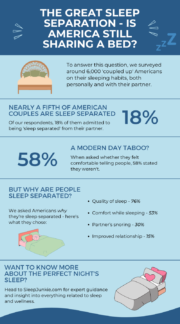America Undercover: What Do Americans Put in Their Beds?
When you get in bed at night after a long day, comfort plays a huge part in determining how long it takes for you to get to sleep. The average sleeper takes about seven minutes to fall asleep, though you may fall asleep sooner or take longer, depending on circumstances.
Everyone sleeps differently — some people with just a comforter and others with three or four pillows. Americans’ bedding habits have changed over the years, and what was once the standard is no longer the norm. Considering this, we began to wonder: Do some people actually prefer to sleep with no blanket on top? Just how many pillows does it take to get a good night’s rest? And are top sheets really no longer a thing?
We wanted to answer these questions — and see if the recent debate holds any truth, about whether millennials are killing the bedding industry. So we completed a survey of more than 2,700 participants in 25 of the country’s largest cities to pull back the covers on exactly how America sleeps. Here are a few things we learned:
- Nearly a third of Americans (32%) have ditched top (or flat) sheets and only use bottom (or fitted) sheets on their beds.
- Millennials can’t be blamed for “killing the bedding industry.” It’s actually Gen Z and Baby Boomers driving the trend: 37.5% of Gen Z’ers and 32.8% of Baby Boomers have given up top sheets, with percentages higher than millennials and Gen X.
- Washing your sheets more often might improve the quality of your sleep. People who are “very satisfied” with their sleep reported washing or changing their sheets every 12.8 days on average. “Very unsatisfied” survey takers averaged 19.9 days between washings.
Let’s take a deeper dive into what Americans use on their beds and how it affects their sleep quality.
America Undercover
Overall popularity of items people put on beds
When temperatures drop, what do you curl up under? There are a number of items you can use to make your bed, including sheets, blankets, duvets, comforters, and many different types of pillows. The possibilities are endless.
When we asked survey participants what items they use on their beds, almost 82% reported using a fitted sheet, while 61.4% stated that they still use a flat sheet. Here we begin to resolve one aspect of the modern bedding debate: Flat sheets are still being used in American bedrooms, though probably not as much as in years past. (Read more on this below.)
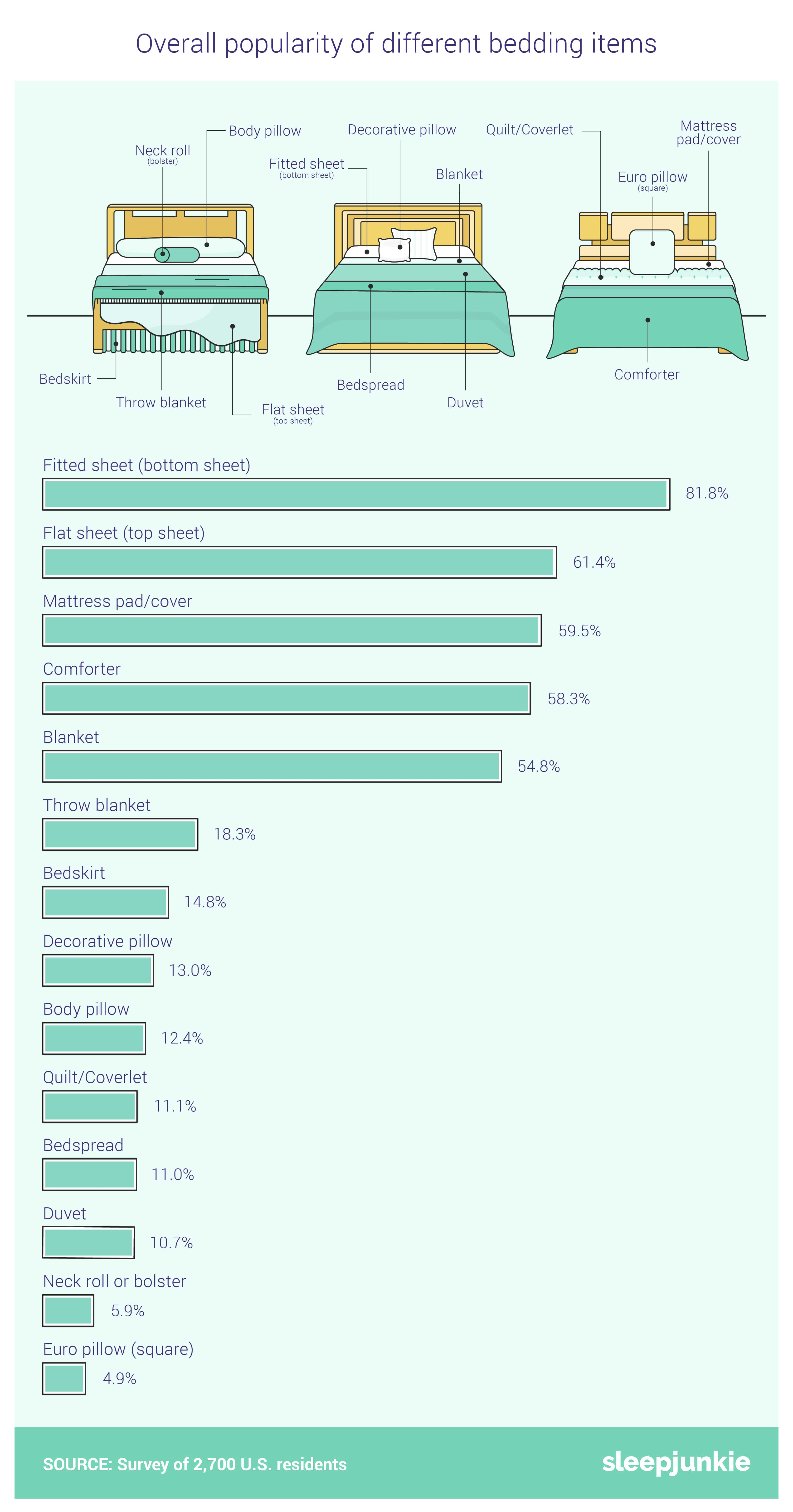
On the under-layer, 59.5% of survey takers reported using a mattress pad or cover, which can be extremely helpful in protecting a mattress from perspiration as well as helping to preserve the mattress warranty.
As far as the top covers, 58.3% of participants said they use comforters, while only 11% use either quilts or bedspreads. All are used to snuggle under when it gets cold, but the main differences are in the thickness and weight. Comforters or duvets are made to be fluffier and thicker, filled with materials such as cotton or down, while bedspreads are generally more lightweight and can be made of wool or chenille, among other materials. Quilts are layered covers usually made of cotton or wool and can be lighter or heavier, depending on the filling.
These typical items are commonly used on beds, but specialized and decorative pillows fall to the bottom of the list. Neck rolls, or bolsters, are used by only 5.9% of our participants. These pillows are specially made for neck support but may also be used as an alternative to back and knee pillows. Euro pillows, or square pillows, are the least likely to be found on the beds of our participants. Only 4.9% reported sleeping with these often-decorative pillows that are used to prop up regular bed pillows (or sometimes just make your bed look nice when it’s made).
The Top Sheet Debate
Flat vs. fitted sheets across the country
Traditionally, sheets have come in sets with a top (flat) sheet, a bottom (fitted) sheet, and a pair of pillowcases. But increasingly, Americans are foregoing the flat sheet. In fact, much has been made in the media about millennials’ bedding habits and the touted “death of the top sheet.” But is it true? And where does everyone else come down on the great debate?
We looked at whether or not sleepers use a flat sheet, broken down by age, gender, and city, and found that, among other surprises, nearly a third of Americans (32%) are in the “fitted sheet only” camp.
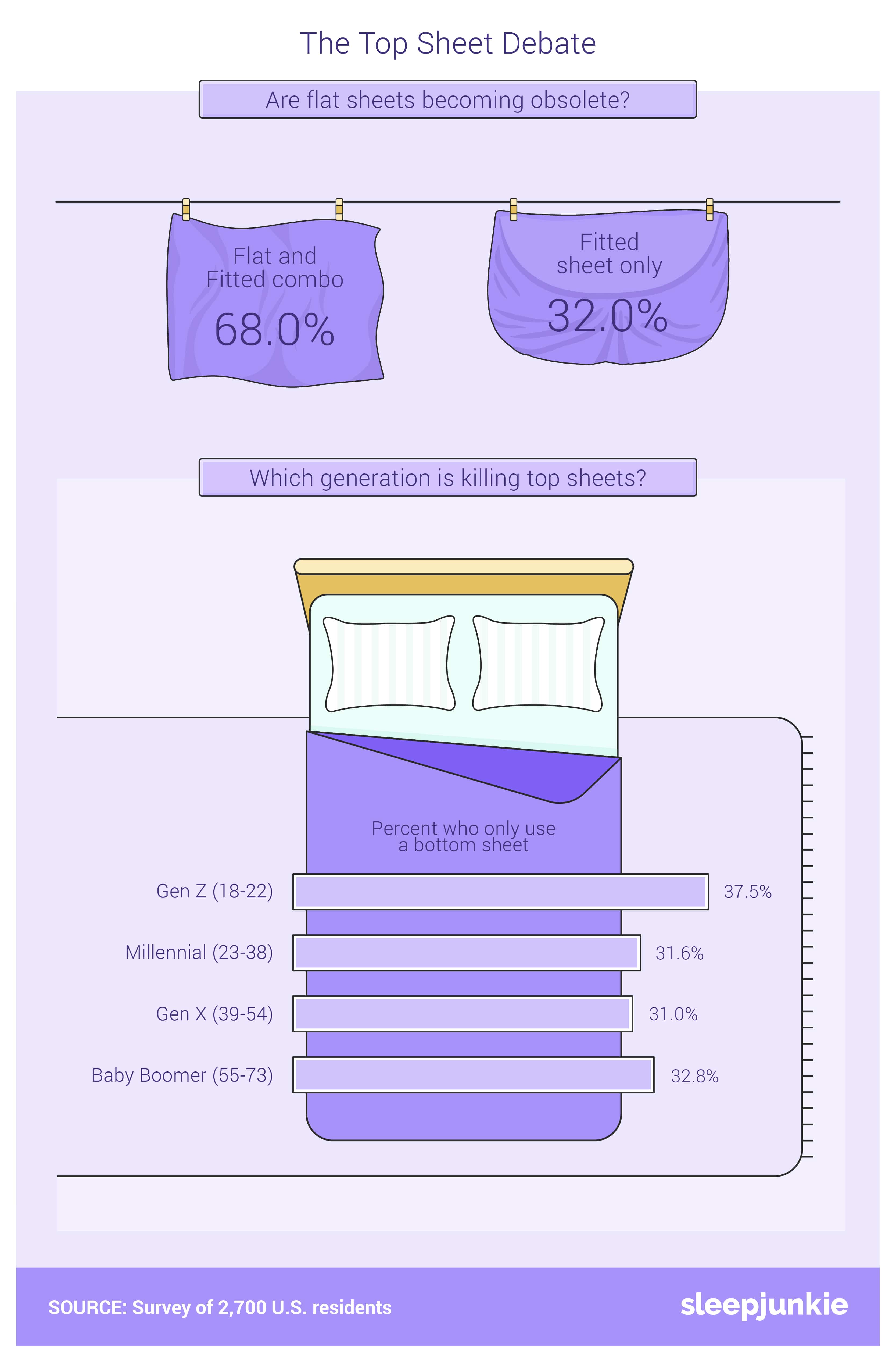
Certainly there are pros and cons of flat sheets, and the cons partially explain why they might seem less useful to some people: While a flat sheet may help you keep your comforter clean, some feel it’s more work to wash than just throwing the comforter cover in the washing machine. (This is debatable, though, as the latter option requires pulling the comforter out of the cover and re-inserting it after laundering.)
It’s also true that flat sheets can help with temperature control, but they’re also likely to end up bunched up or twisted in the middle of the night, which can be frustrating when you’re trying to get a good night’s rest.
The myth that millennials are killing the flat sheet industry has been debunked, at least by our survey. Though 31.6% of millennials prefer not to use a flat sheet, there are higher percentages of both Generation Z (37.5%) and, surprisingly, Baby Boomers (32.8%). While millennials may be to blame for killing other trends, they are not solely to blame for the “disappearance of the top sheet.”
It should also be noted that in 2019, Generation Z overtook millennials as the largest generation of Americans. So theoretically speaking, if the highest percentage of people not using flat sheets comes from the largest generation, then Gen Z’ers are more accountable for killing the flat sheet than millennials… if it’s really even dying, that is.
In reality, furniture and bedding sales have steadily risen during the past 10 years, despite rumors to the contrary. So even if flat sheets aren’t being used as much, they’re still being bought and sold, giving consumers the option to choose whether or not they want to join Team Fitted Sheet Only.
Ditching Flat Sheets by City
How does this debate break down geographically? Participants from 25 cities responded with their flat-vs-fitted preferences, and the results are all over the map.
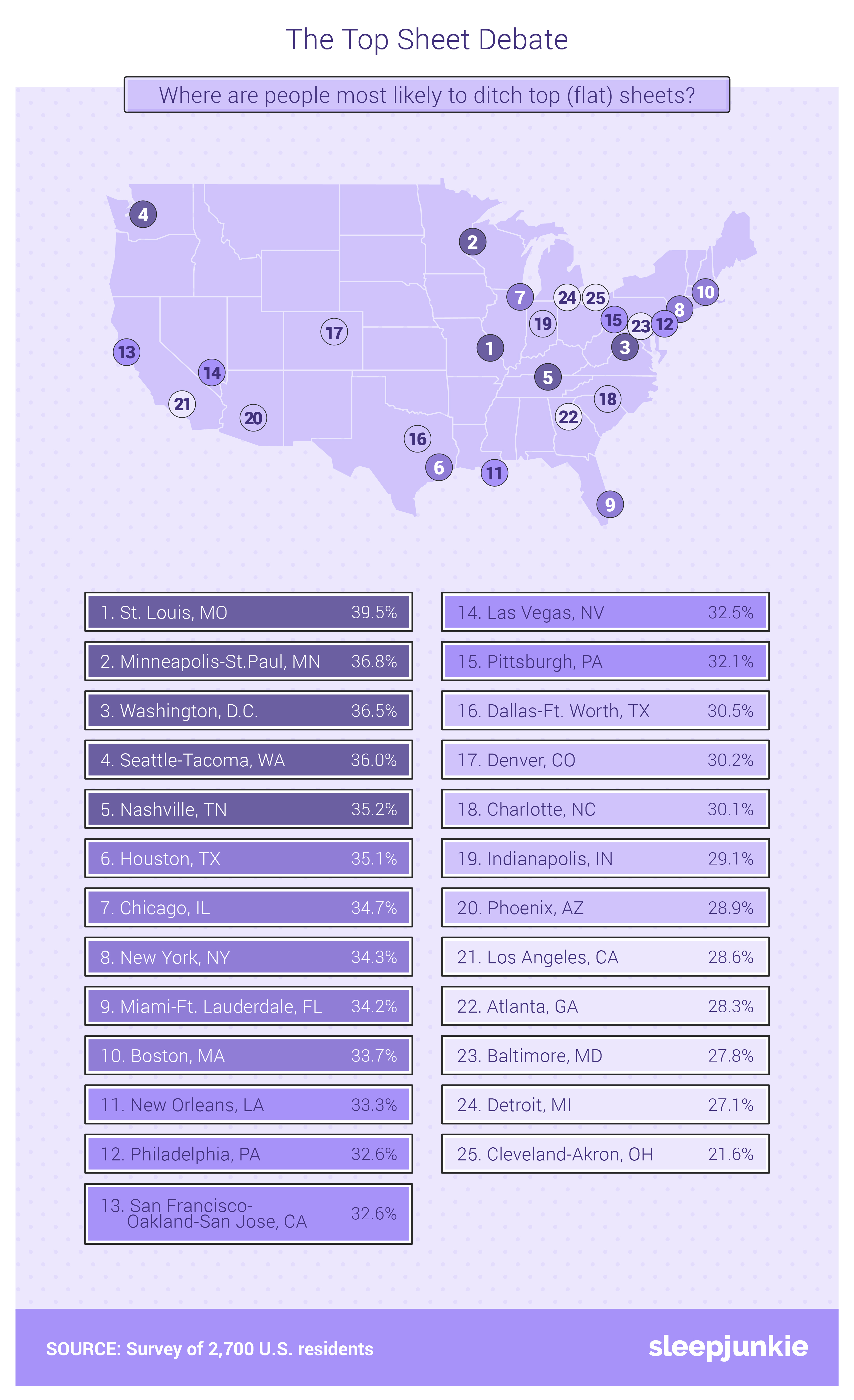
Residents of St. Louis are the most likely population in the country to ditch the top sheet and use only a fitted sheet, while Cleveland inhabitants are more likely to use a flat sheet than any of the other participants. These Midwestern cities share plenty of characteristics, but not when it comes to bedding.
Out of these 25 major cities, 18 of them rank between 30% and 40% unlikely to use a flat sheet. The results show that geographically, where participants live imposes no relevance on whether or not they choose to use a flat sheet — though it’s worthy to note that Cleveland residents are overwhelmingly likely to use both flat and fitted sheets on their beds, at almost 80%.
Flat vs. fitted sheets across the country
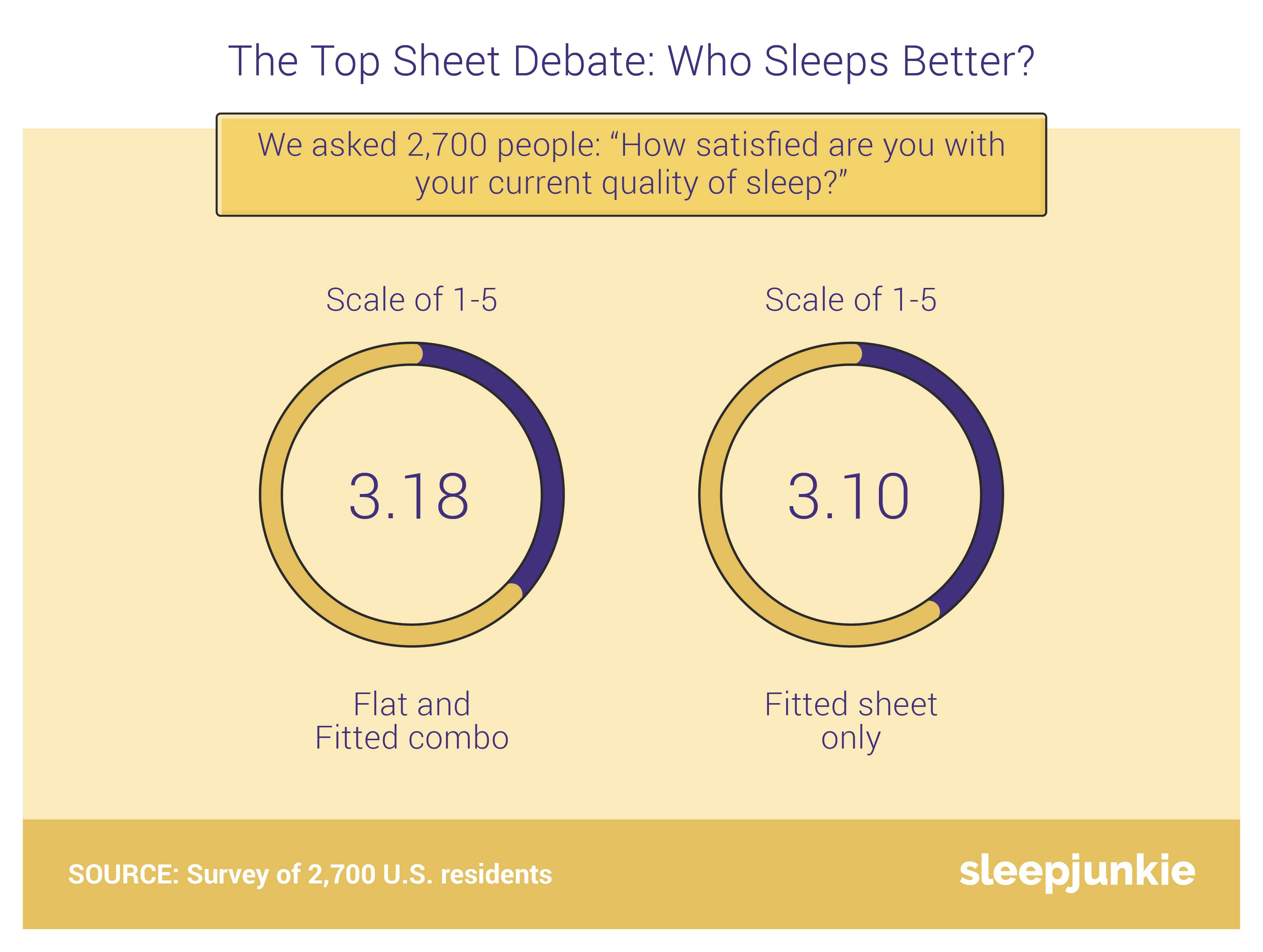
When it comes to getting a good night’s sleep with or without a flat sheet, our survey results show there’s a slight difference between the two. On a scale of 1 to 5 (1 being Very Unsatisfied and 5 being Very Satisfied), participants who sleep with the flat and fitted combination of sheets report an average satisfaction of 3.18, while those who sleep with only a fitted sheet report an average of 3.1 out of 5. Because the difference isn’t that significant, the results seem to boil down to a personal preference rather than any scientific explanation.
Thankfully, most companies still sell sheet sets that include both a flat and fitted sheet, so if you’re curious about which brings you better sleep, you can try out each method without having to spend extra money.
Pillow Fight
What is the ideal number of pillows?
Some surveys show that nine in ten people believe having comfortable pillows is an important factor in getting a good night’s sleep. About seven in ten of our respondents rated pillows as making a big impact on their ability to get a good sleep.
When we asked our participants how many pillows are usually on their bed, 30.6% answered that they sleep with two pillows; and 13.3% sleep with thsree pillows. The number jumps up again with four pillows, at 27.4%. These results show that participants sleep with an average of 2.2 pillows on their beds.
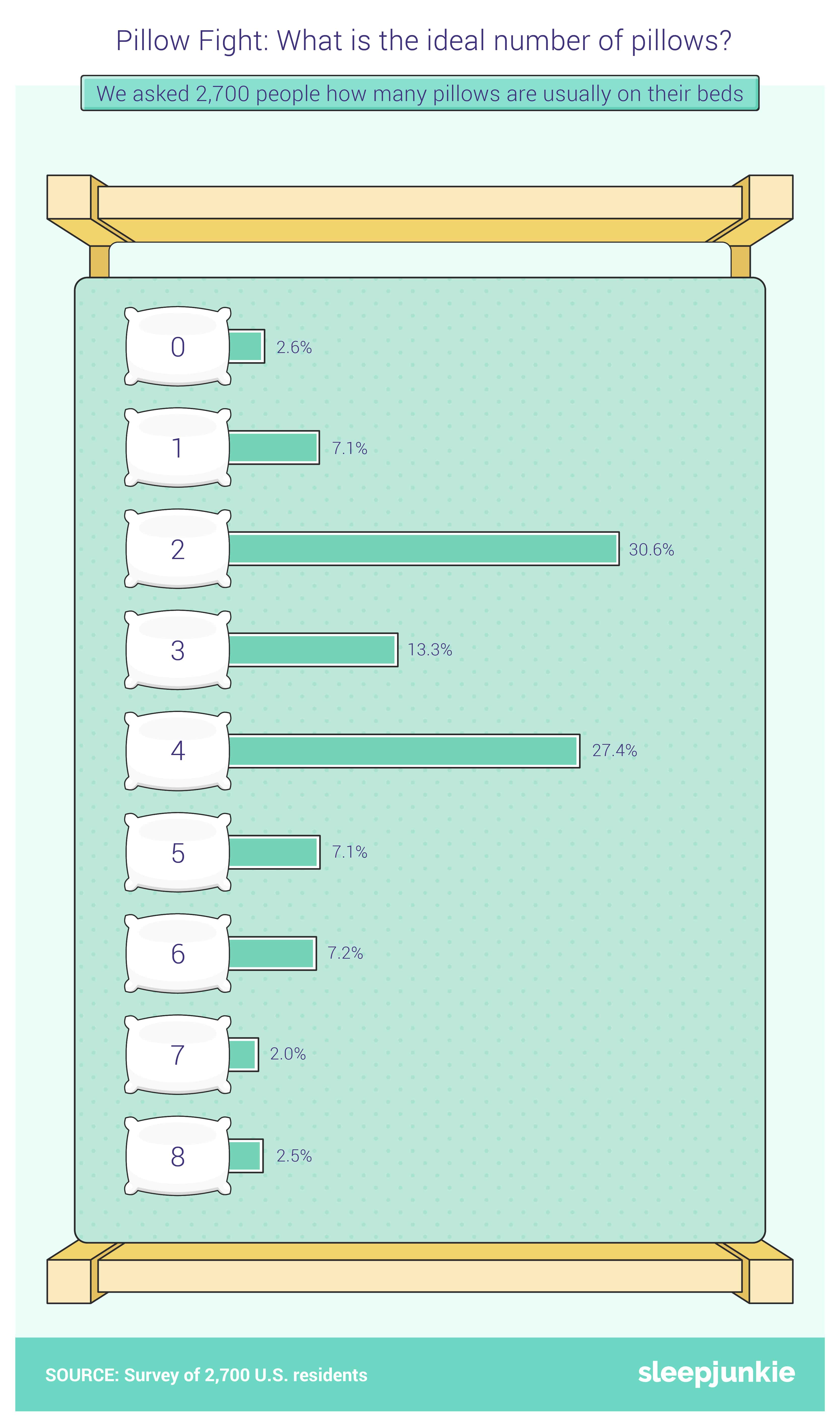
Home goods stores tend to cater to the tastes and preferences of women, but when it comes to pillows, men actually use more. Men reported an average of 3.49 pillows on their beds while women reported an average of 3.35.
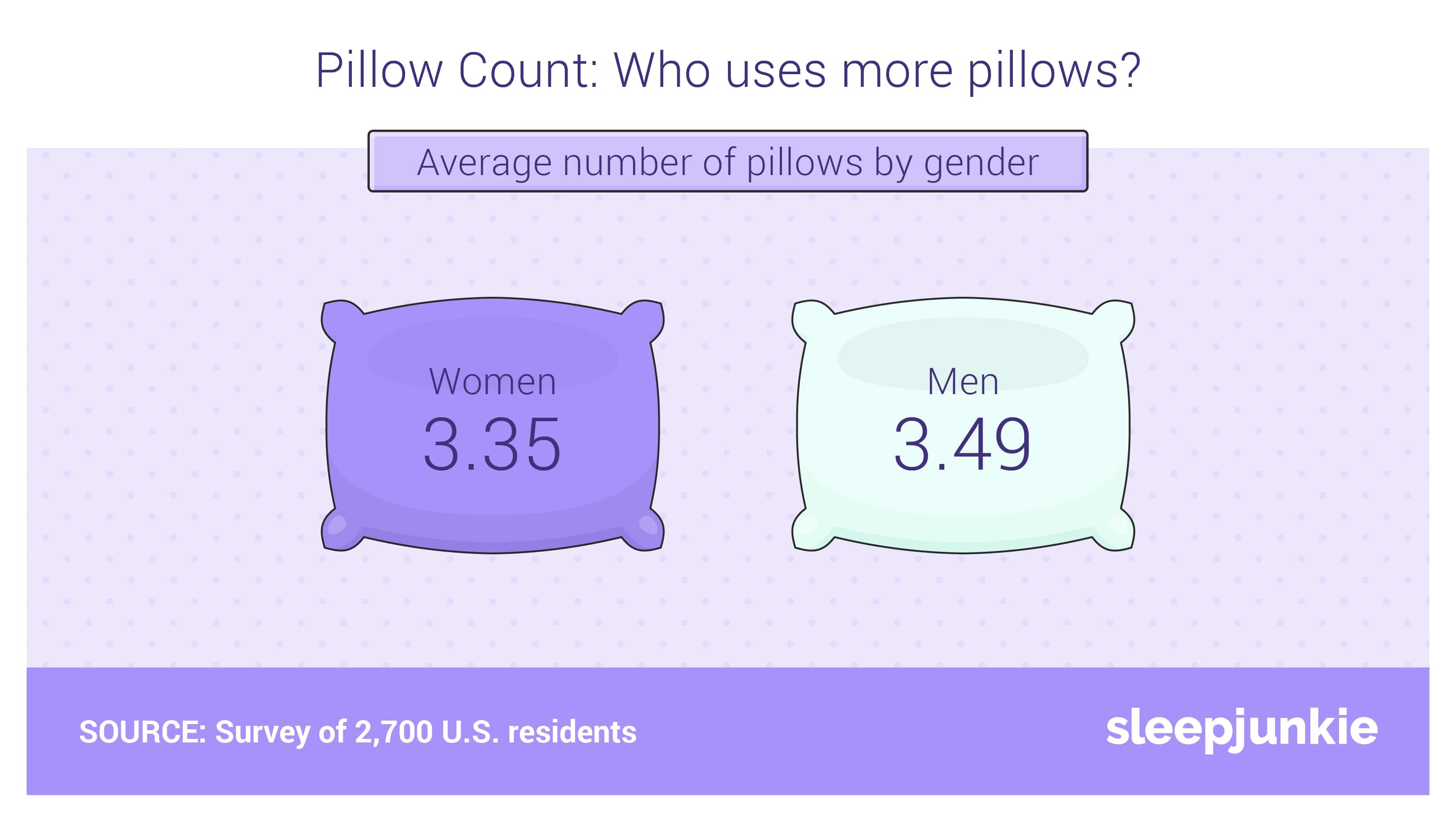
The number of pillows on your bed can also affect your nighttime slumber. Our survey results suggest that on a scale of 1 to 5, people who are more satisfied with their sleep average 3.2 pillows in their beds while those less satisfied average 3.46.
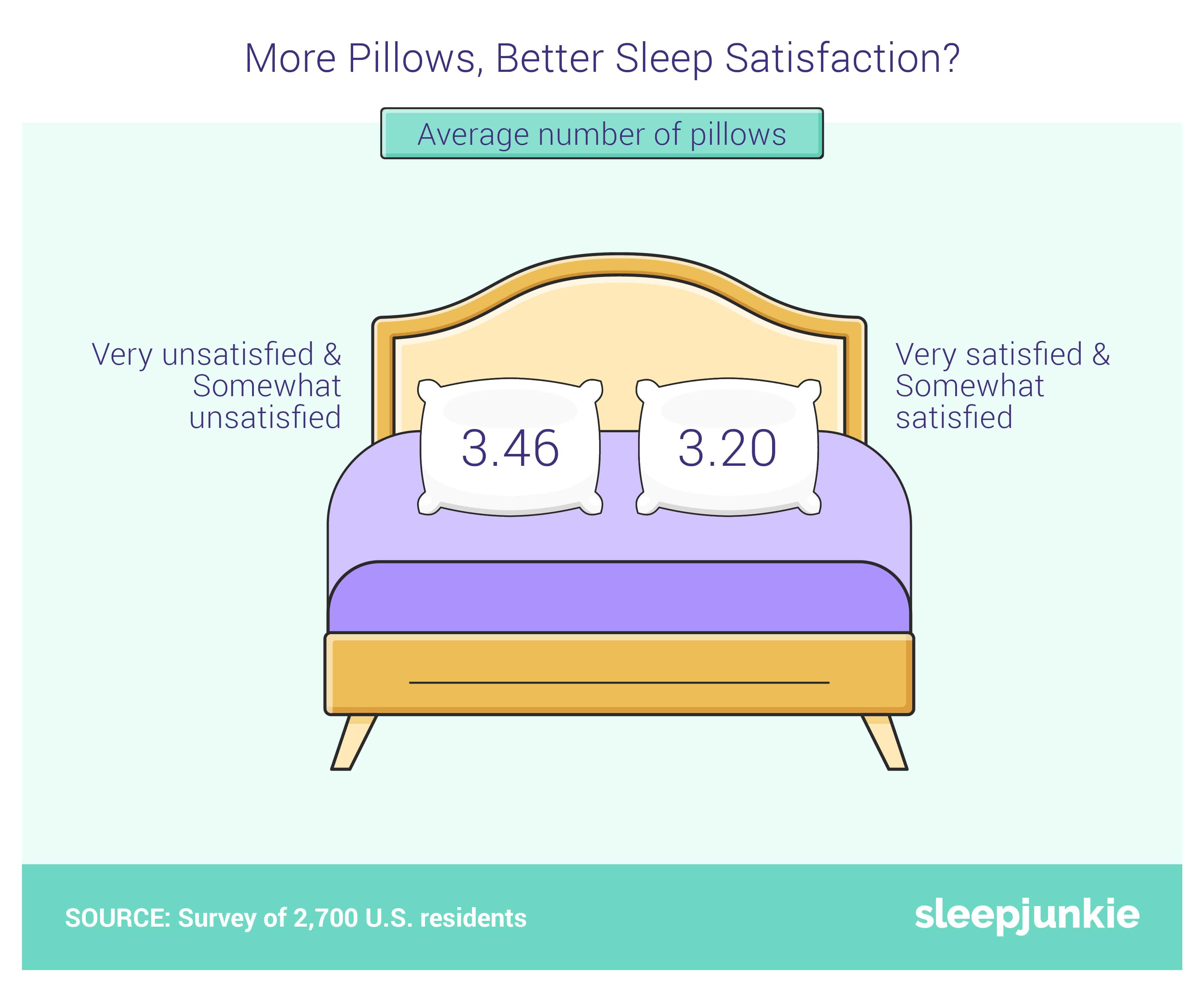
While many people choose to sleep with several pillows, experts actually recommend that you sleep with just one pillow a night beneath your head. Sleeping with too many pillows under your head can lead to neck and spine issues, so when you’re looking to keep your spine aligned during your slumber, less is more.
One pillow is ideal to rest your head on, but additional pillows may also be used depending on which way you sleep. If you sleep on your side, an additional pillow is recommended between your knees to relieve stress on the lower back and hips by keeping your top leg from pulling your spine out of alignment.
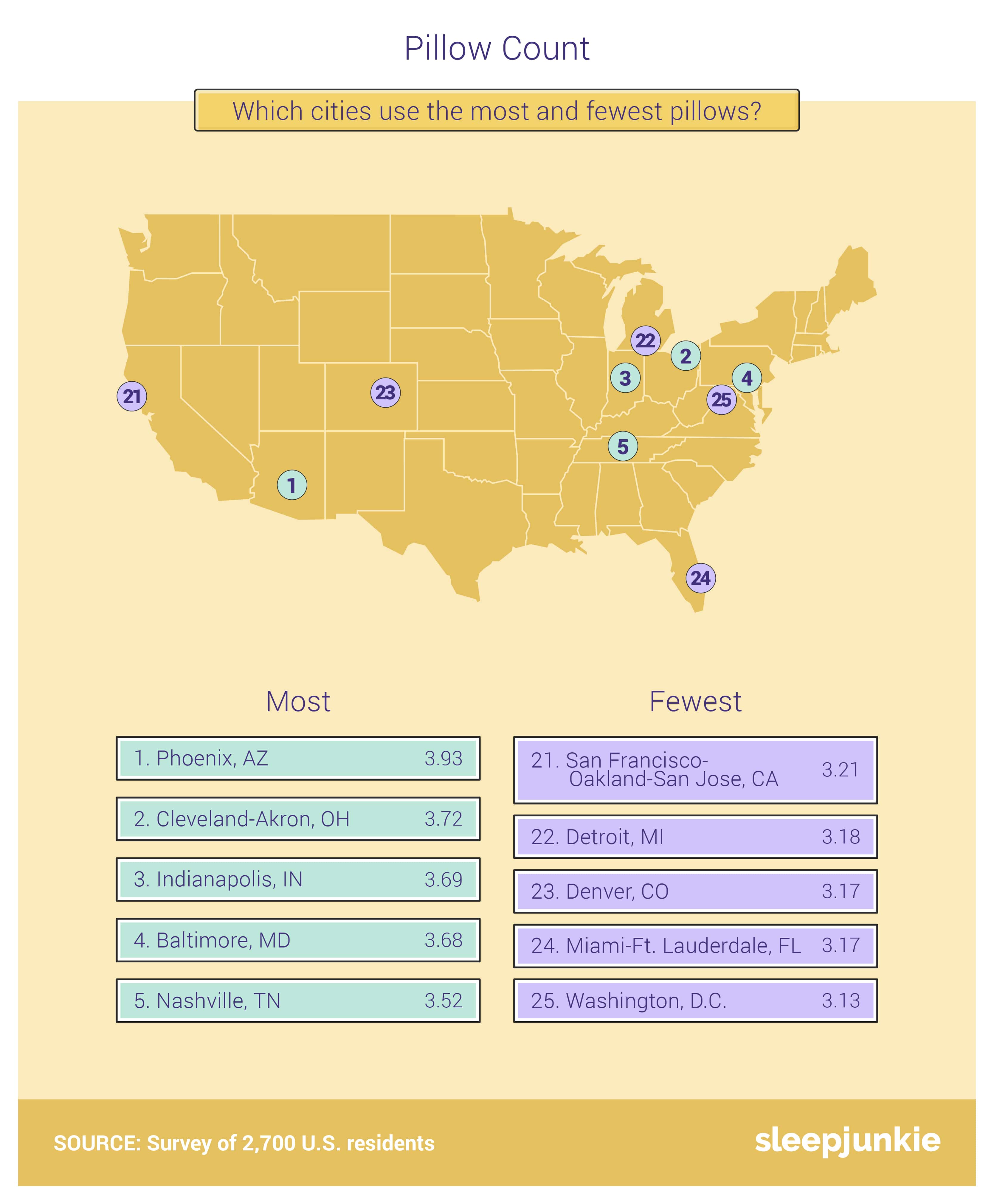
According to our survey respondents, Phoenix hosts the most pillow-loving people in the United States, averaging nearly 4 pillows on every bed. It’s followed by the Cleveland-Akron area with 3.72, then Indianapolis and Baltimore.
Residents of Washington, D.C., are the most minimalist in their pillow preferences. They have the fewest pillows per bed, with an average of 3.13. Miami, Denver, and Detroit are also fairly frugal when it comes to piles of pillows.
Washing Sheets
How often should you wash your bedding? And… how often do you actually wash it?
On average, it’s recommended that you wash sheets once a week, but that doesn’t always work out as planned. Going two weeks between washing your sheets can be an acceptable stretch, but anything longer than that can end up being bad for your health.
If you can’t wash your sheets as often as you’d like, having a second or third set of sheets on hand for more frequent changes can prove to be beneficial.
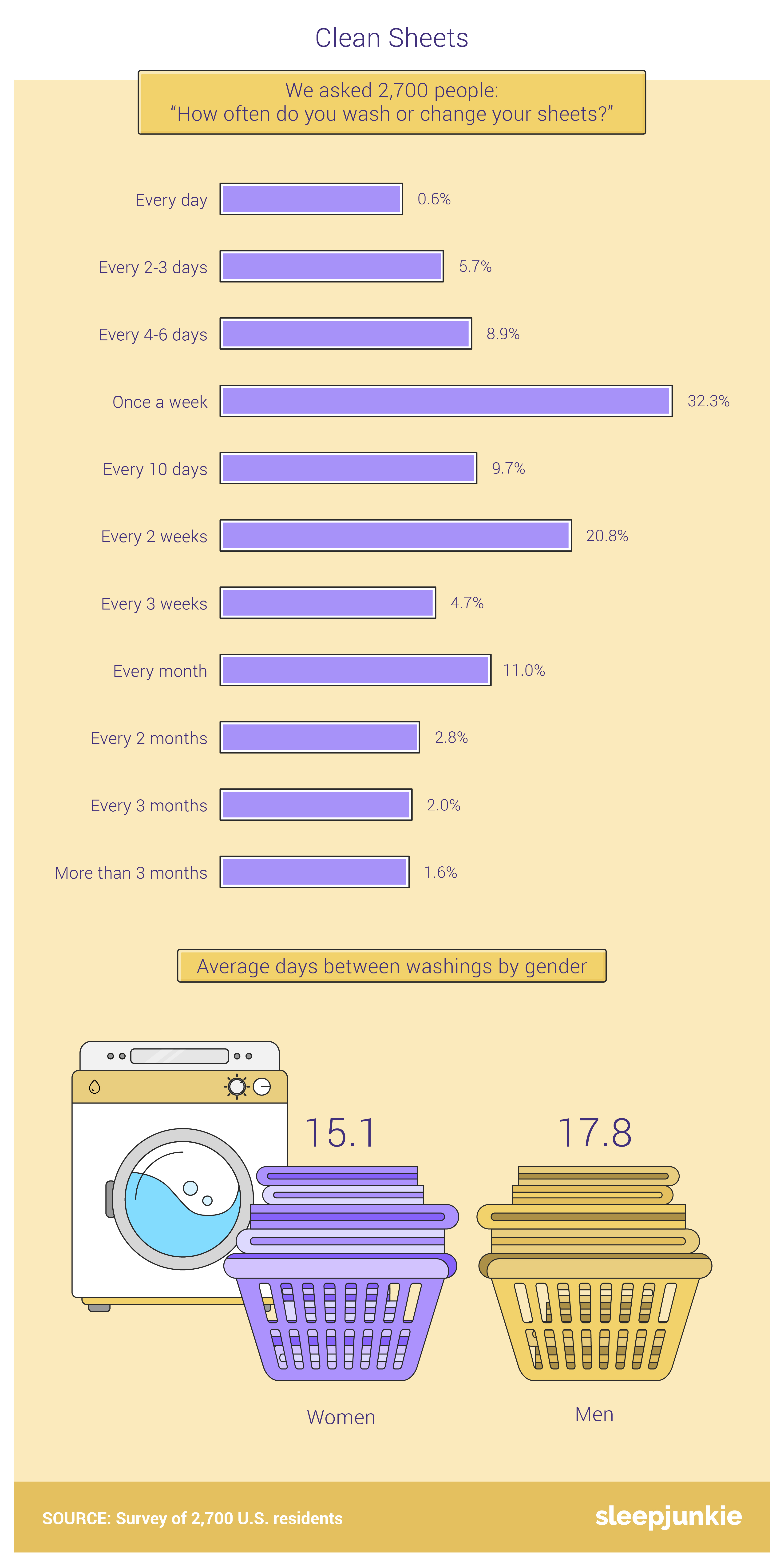
A total of 78% of our survey participants reported that they wash their sheets at least every two weeks. 32.3% wash their sheets once a week; 20.8% wash every two weeks; and 11% confessed that they wash their sheets once a month. A little more than 6% go between two and three or more months to wash their linens, while super-clean outliers at 0.6% wash their sheets every day.
The amount of time it takes to wash sheets also varies by gender and location. The survey found that women take an average of 15.1 days to wash their sheets, while men take 17.8 days.
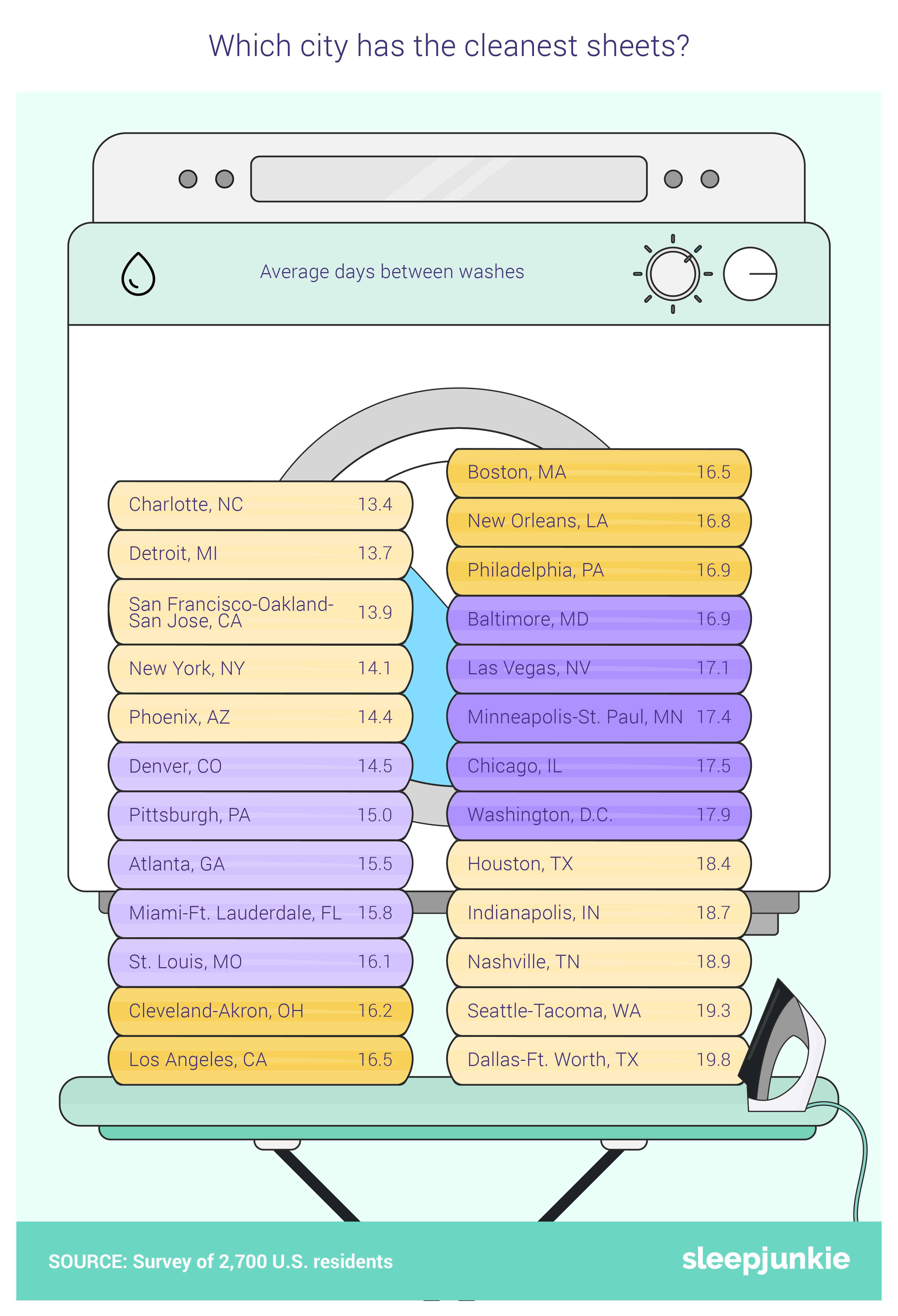
Geographically speaking, different participants from around the country choose to wash their linens on markedly different schedules. Participants from Charlotte wash their sheets on average every 13.4 days; Boston and Los Angeles participants, in the middle of the pack, every 16.5 days.
At the bottom end of the rankings, Dallas-Ft. Worth residents wash their sheets on average every 19.8 days — waiting nearly a full week longer between washings than the most frequent launderers, in Charlotte.
Considering how much time we spend sleeping in our beds and making direct body contact with the sheets, it’s highly recommended to keep them as clean as possible, as often as possible. And if you or a spouse experience dust or pollen allergies or a contagious illness, your laundering schedule should be even more frequent.
Does it really matter? Well, if hygiene isn’t enough to convince you, then consider this: Our survey suggests a correlation between washing sheets more often and being “very satisfied” with the quality of your sleep.
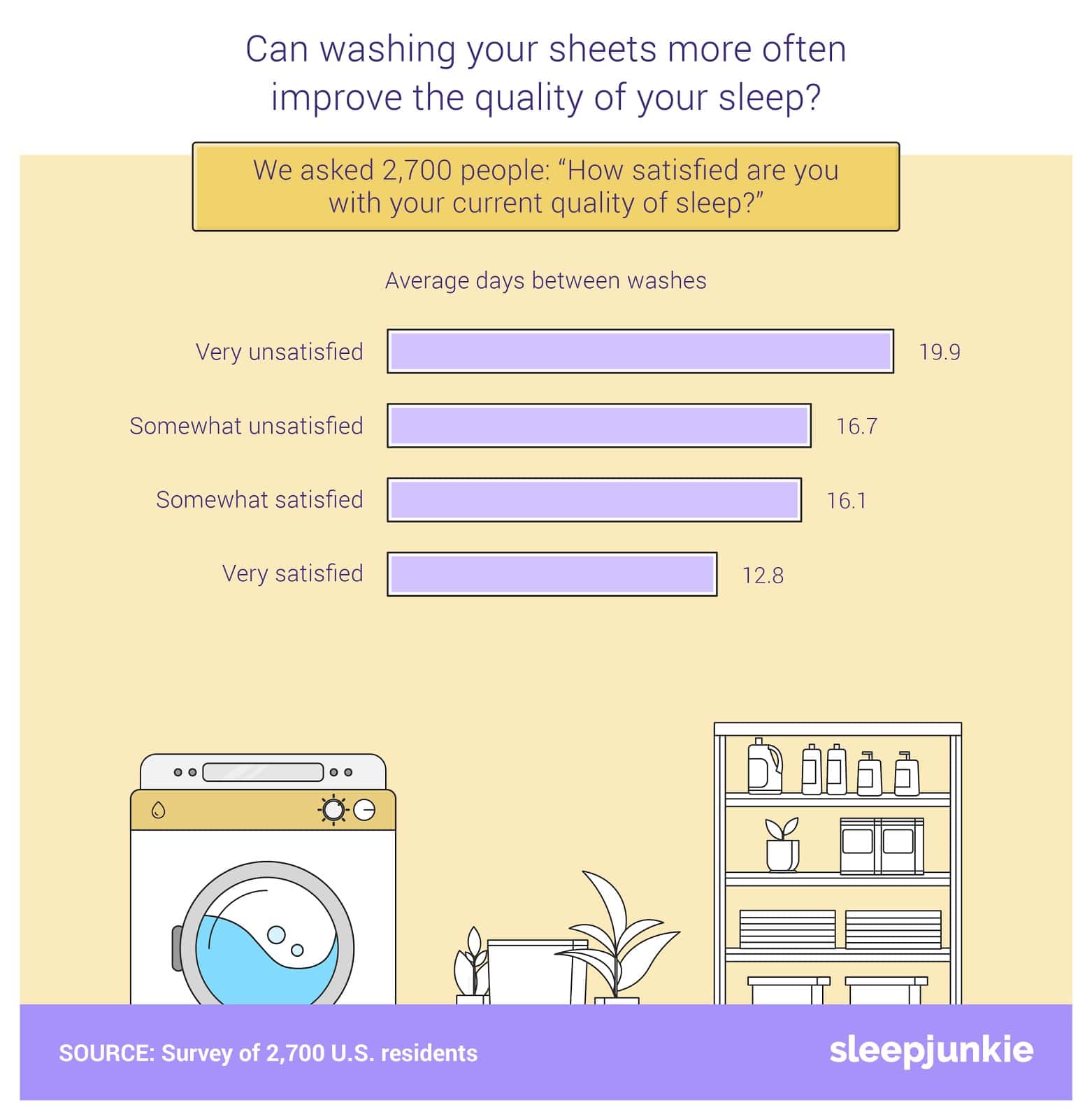
When respondents were asked how satisfied they are with their current quality of sleep, the higher number of days between washes correlated with less satisfaction. Those who responded with “very satisfied” ratings for their sleep quality waited an average of 12.8 days between trips to the laundry. Those who reported being “very unsatisfied” with the quality of their sleep wait a full week longer, at 19.9 days.
If you’ve ever wondered why you can’t get a good night’s rest, it might be because of your bed linens. Washing your sheets can improve your sleep quality. Apparently, people just sleep better when their sheets are clean.
Good Night to All
68% of Americans struggle to fall asleep at least once a week. Many factors can contribute to this phenomenon, including what you’re falling asleep on and what shape the bedding is in. If you’re not comfortable, it’s likely you won’t be able to fall asleep as quickly or sleep as well as someone who is.
Responding to the findings of the survey, Sleep Junkie editor Meg Riley had this to say:
“Few elements are more important to human brain function than sleep, and the quality of that sleep can be affected by numerous factors. Especially eye-opening in this survey was the sizeable gap between people who reported themselves ‘very satisfied’ with their quality of sleep and those who were ‘very unsatisfied’; the most diminished satisfaction corresponded with an extra week’s delay in washing sheets. We can see from the survey’s overall results that the quality and condition of bedding makes a huge difference in the general sleep experience.”
Undoubtedly, finding a good combination of pillows and bedding can make the difference between waking up refreshed versus waking up on the wrong side of the bed. And the choice is not always obvious: Sleeping on a bed full of pillows may sound like a dream, but it could also cause you to wake up in a nightmare of pain. And while a thick comforter may be a good idea in the wintertime, it’s clearly not the best idea during the scorching temperatures of the summer. With an appropriate number of pillows and just the right combination of clean bedding, it can become much easier to go undercover for a good night’s sleep.
Methodology
We surveyed 2,712 U.S. residents for this study, including at least 100 people in each of the 25 cities featured in the report. The cities were chosen based on their populations, geographic locations, and media market sizes. The survey was conducted online.
Respondents were 50.5% women and 49.5% men. They ranged in age from 18 to 82, with a median age of 34. The sample included 256 Baby Boomers, 691 Generation Xers, 1,629 Millennials, and 136 members of Generation Z.
The survey was based on self-reporting. Respondents who missed an “attention check” question were disqualified. The margin of error was ±1.882% with a confidence interval of 95% based on the total population of adults in the target cities.
Fair Use
Are you a journalist or blogger interested in covering this project? You can rest easy knowing we grant permission to reproduce any of the assets above for noncommercial purposes. All we ask is that you credit the authors appropriately and link back to this page so your readers can learn more about the study and its methodology.

